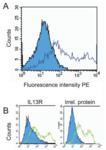Product Details
| Alternative Name: | IL-13R, CD213, Interleukin-13 receptor |
| |
| Clone: | GM-1C8 |
| |
| Host: | Mouse |
| |
| Isotype: | IgG1 |
| |
| Immunogen: | Vector containing the cDNA of the extracellular domain of human IL-13Rα1 (interleukin-13 receptor α1 chain). |
| |
| UniProt ID: | P78552 (subunit α1), Q14627 (subunit α2) |
| |
| Source: | Purified by affinity chromatography from cell culture supernatant. |
| |
| Species reactivity: | Human
|
| |
| Applications: | Flow Cytometry
|
| |
| Quality Control: | Routinely tested by flow cytometry on BOSC cells transiently transfected with a IL-13Rα1 expression vector. |
| |
| Formulation: | Liquid. Antibody in PBS, pH 7.2, containing 0.01% sodium azide. |
| |
| Handling: | Avoid freeze/thaw cycles. |
| |
| Shipping: | Blue Ice |
| |
| Short Term Storage: | +4°C |
| |
| Long Term Storage: | -20°C |
| |
| Scientific Background: | IL-13 is an immunoregulatory cytokine secreted predominantly by activated TH2 cells, as well as mast cells and basophils, and is a key mediator in the pathogenesis of allergic inflammation. The human IL-13 receptor (IL-13R) is a heterodimer composed of the interleukin-4 receptor a chain (IL-4Rα) and an IL-13 binding protein, IL-13Rα1.A second IL-13 binding protein, IL-13Rα2, has also been identified, which is believed to act as a "decoy" receptor. IL-13 receptors are expressed on human B cells, basophils, eosinophils, mast cells, endothelial cells, fibroblasts, monocytes, macrophages, respiratory epithelial cells, and smooth muscle cells. However, functional IL-13 receptors have not been demonstrated on human or mouse T cells.
As with other cytokine receptors, the cytoplasmic tails of IL-4 and IL-13 receptor subunits associate with tyrosine kinases of the Janus family (JAK 1 |
| |
| Regulatory Status: | RUO - Research Use Only |
| |

Figure: Specificity testing of GM-1C8. BOSC cells were transiently transfected with an expression vector for the extracellular domain of IL-13Ra1 as well as an irrelevant protein. Expression of the constructs was tested with an anti-tag monoclonal antibody (B, open curves), an irrelevant monoclonal antibody served as negative control (filled curves). For specificity testing (A), GM-1C8 hybridoma supernatant was tested on both the IL-13Ra1 and the irrelevant protein transfectants. A positive signal was obtained only with IL-13Ra1-transfected cells.
Please mouse over
Product Literature References
Blockade of interleukin-13-mediated cell activation by a novel inhibitory antibody to human IL-13 receptor �1: S. Krause, et al.; Mol. Immunol.
43, 1799 (2006),
Abstract;
General Literature References
IL-13 receptors and signaling pathways: an evolving web: G.K. Hershey; J. Allergy Clin. Immunol.
111, 677 (2003), (Review),
Abstract;
Interleukin-4 and interleukin-13 signaling connections maps: A.E. Kelly-Welch, et al.; Science
300, 1527 (2003),
Abstract;
Structure, binding, and antagonists in the IL-4/IL-13 receptor system: T.D. Mueller, et al.; Biochim. Biophys. Acta
1592, 237 (2002), (Review),
Abstract;
IL-4/IL-13 signaling beyond JAK/STAT: H. Jiang, et al.; J. Allergy Clin. Immunol.
105, 1063 (2000), (Review),
Abstract;
Differential responses of human monocytes and macrophages to IL-4 and IL-13: P.H. Hart, et al.; J. Leukoc. Biol.
66, 575 (1999), (Review),
Abstract;
Interleukin-4 and interleukin-13: their similarities and discrepancies: P. Chomarat and J. Banchereau; Int. Rev. Immunol.
17, 1 (1998), (Review),
Abstract;










